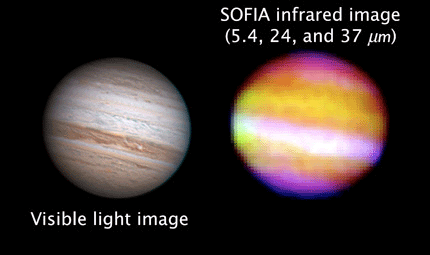 Jupiter seen in infrared light through SOFIAAfter nearly a 14-year hiatus, NASA is once again conducting astronomical observations…from the stratosphere!
Jupiter seen in infrared light through SOFIAAfter nearly a 14-year hiatus, NASA is once again conducting astronomical observations…from the stratosphere!
SOFIA—the Stratospheric Observatory For Infrared Astronomy, a joint project between NASA and Germany—made its scientific debut in a "first light" flight on May 26th. That is, after a few years of test flights focused on the mechanical and aerodynamic engineering aspects of this 747-with-telescope, a science team acquired the observatory's first astronomical data.
Some of you may be thinking, NASA has an observatory built into an airplane? Really?
I had the same thought, until a job opening came up on NASA's previous flying telescope, the Kuiper Airborne Observatory. It was 1989, I was freshly back from my Peace Corps tour in Africa, and I was looking for a job. My physics advisor told me of the job opening, and I quickly put together a resume and sent it in.
I was invited to an interview, then waited a couple weeks with no word from my would-be employer. Sooooo…I called their HR office to ask if the position had been filled. "We have decided to offer you the position," the woman responded, "and, can you start on Tuesday? And…do you think you would be able to go to New Zealand on Friday for training?"
